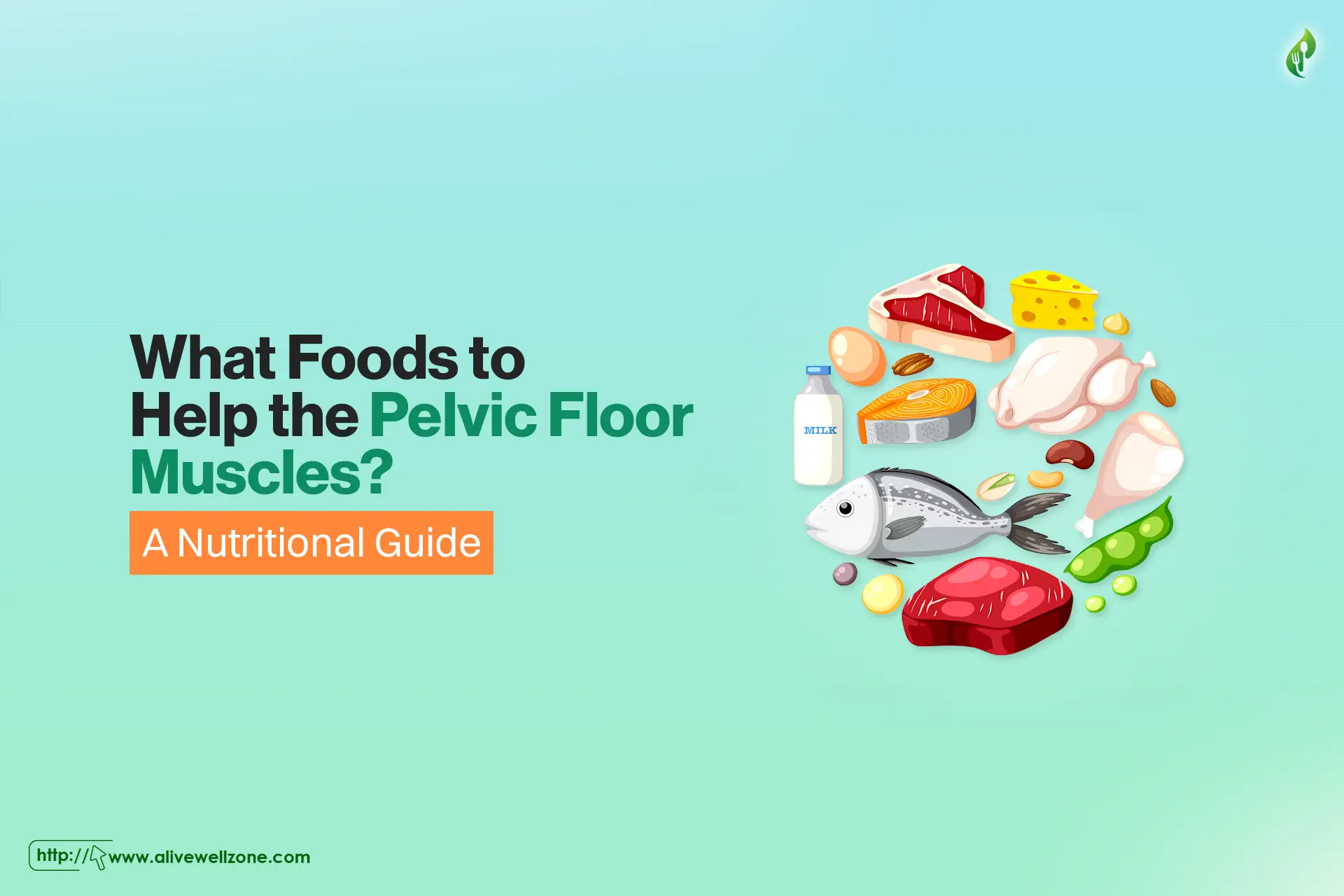
Last Updated on November 8, 2024 by Helena Akter
Tired of dealing with leaks or that uncomfortable pressure downstairs? You’re not alone. A weak pelvic floor can be a real pain. But guess what? If you know what foods to help the pelvic floor muscles, you can wave it off.
You can eat foods like omega-3-rich fish, eggs, fiber-filled avocados and bananas. Plus, staying hydrated and incorporating protein-rich foods also help. These help prevent urinary incontinence and pelvic pain. And avoid bladder irritants like caffeine, alcohol, and spicy foods to manage pelvic congestion.
In addition to the foods, you’ll know about natural herbs that can help your pelvic muscles. Moreover, we’ll share top exercises to help you get overall balance. So, keep reading!
Key Takeaways
- Pelvic Floor Health Symptoms: Weak pelvic floor muscles can lead to urinary leaks, pelvic pressure, bowel issues, and pain in the lower back or pelvis.
- Diet and Nutrition: Drink plenty of water, and eat foods rich in omega-3 fatty acids, protein, bananas, eggs, and avocados. These foods support pelvic health by reducing inflammation, promoting muscle repair, and preventing constipation.
- Herbal Remedies: Herbs like Calendula, Ginger, and Ocotillo bark can improve blood flow, reduce congestion, and alleviate pain in the pelvic region. That way you can provide natural support for pelvic floor health.
- Foods to Avoid: To manage conditions like Pelvic Congestion Syndrome, you should avoid bladder irritants such as caffeine, alcohol, and acidic fruits. Also, stay away from carbonated drinks, artificial sweeteners, and spicy foods.
- Exercises for Strengthening: Exercises like Kegels, bladder training, and pelvic tilts are vital for building and maintaining strong pelvic floor muscles. They help to prevent leaks and improve overall stability.
Symptoms of Weak Pelvic Floor Muscles
A weak pelvic floor can cause several problems. These symptoms often overlap with other pelvic issues —
- Urinary leaks: Accidentally peeing when coughing, sneezing, laughing, exercising, or lifting heavy things.
- Pelvic pressure: Feeling like something is pushing down or falling out.
- Vaginal changes: A wider vagina that makes tampons slip out, vaginal bleeding outside of your period, or discomfort or pain during sex.
- Bulges: Noticeable tissue sticking out of the vagina that might hurt or bleed.
- Pain: Ache in your pelvis or lower back, especially when standing for a long time.
- Bowel problems: Constipation or trouble fully emptying your bowels.
- Urinary troubles: Frequent urination, difficulty peeing, or repeated urinary tract infections.
What Foods to Help the Pelvic Floor Muscles?
A strong pelvic floor is vital for an improved overall health and well-being. Now, what you eat and drink plays a big role in keeping your pelvic floor healthy.
So, let’s explore some that can support your pelvic floor health.

1. Water
Staying hydrated is vital for a healthy pelvic floor. It helps prevent constipation, which can strain these muscles. Believe it or not, 75% of Americans are often dehydrated, which only worsens these problems.
Water is also better for your bladder than other drinks like tea, coffee, or soda. These drinks can irritate your bladder. Water, on the other hand, helps your body stay clean inside. Plus, it keeps your urinary system healthy.
It also helps your bladder fill up properly, so you know when you need to go. Make sure to drink plenty of water throughout the day to resist horrible dehydration’s effects.
2. Omega-3
Most of us eat too many omega-6 fats. These fats are often found in junk food and vegetable oils. According to experts, these fats can cause inflammation and problems with your pelvic floor.
Meanwhile, Omega-3 fats are really good for your body. They help reduce inflammation, which is great if you have pelvic floor problems. Unlike bad fats like vegetable oil and junk food, omega-3s help calm your body.
You can find omega-3 fats in fish like salmon, anchovies, and tuna. You can also get them from —
- Fish oil pills
- Flax seeds
- Chia seeds
- Walnuts
You can even opt for an animal based-diet which gives you overall health benefits. In fact, it’s recommended to eat or take about 2,000 to 3,000 milligrams of omega-3s each day.
Besides helping your pelvic floor, omega-3s are good for your heart, which can help your overall health and sex life. Eating foods with omega-3s is a simple way to feel better.
3. Eggs
You should know that you need vitamins to heal pelvic floor dysfunction. And eating foods with vitamin D is one of the natural ways to help strengthen pelvic floor. They’re packed with good stuff for your body, including vitamin D.
It helps keep your pelvic floor strong. Plus, studies show that people with more vitamin D are less likely to have weak pelvic floor muscles.

This vitamin makes your muscles stronger, including the ones in your pelvic floor.
Moreover, your body needs vitamin D to use its muscles properly. You can get vitamin D from foods like fatty fish, milk, and especially eggs. But the best way to get vitamin D is from the sun.
4. Protein
Protein is super important for strong pelvic muscles. It helps repair and build your muscles, including the ones in your pelvic floor. To get the most out of protein, eat a variety of foods like meat, fish, beans, and nuts.
For a quick protein boost, try snacks like —
- Greek yogurt with nuts.
- A quinoa and bean salad.
- Celery with peanut butter.
- Cottage cheese and turkey roll-ups are also good choices.
Even if you don’t eat meat, you can still get plenty of protein. Foods like —
- Lentils
- Tofu
- Peas
- Beans are great for building muscle.
5. Avocados
Avocados are one of the best foods to strengthen pelvic muscles. They’re full of fiber, which helps with constipation. Constipation can be bad for your pelvic floor.
Plus, Avocados also have vitamins C, E, K, and B6. These vitamins help strengthen your pelvic floor muscles.
Besides, Avocados can help your body get rid of extra water weight. It’s good for your overall pelvic health. Studies show that eating lots of fiber can help with constipation problems, especially for women with pelvic floor issues.
Besides avocados, you can eat foods like
- Whole grains
- Barley
- Oatmeal
- Broccoli
- Peas to get more fiber.
6. Bananas
Bananas are a fantastic food to eat pelvic to be stronger. They have vitamins and minerals that can help with digestive problems like IBS or lactose intolerance. And it often bothers people with pelvic floor issues.
Also, bananas can help your bladder relax, which can be good if you have trouble holding your pee. Most importantly, the magnesium in bananas can help ease pelvic pain. It helps your body go to the bathroom more easily.
However, you should watch how your body reacts to bananas because they might cause constipation for some people.
Foods to Avoid with Pelvic Congestion Syndrome
Pelvic Congestion Syndrome can be uncomfortable. What you eat can make a big difference. Some foods can bother your bladder and pelvic area, making you feel worse.
Here’s what to watch out for —
- Caffeinated drinks: Coffee and tea act as diuretics. They cause your body to produce more urine. Hence, it can make your bladder more sensitive and overworked.
- Acidic fruits and veggies: Foods like tomatoes, cranberries, and oranges can irritate your bladder lining due to their acidity.
- Alcohol: It speeds up how quickly your kidneys process fluids. So, you get more frequent trips to the bathroom. It can be especially bothersome if you have pelvic congestion.
- Carbonated drinks: Even diet soda can be a problem. They often have caffeine or other stuff that irritates your bladder.
- Artificial sweeteners: They’re another thing to watch out for. Products like Splenda can have the same irritating effect as carbonated drinks.
- Spicy foods: While they might be delicious, they can cause a burning sensation. You won’t feel that just in your mouth but also in your bladder, leading to irritation.
Therefore, to feel better, try to eat and drink less of these things.
Best Herbs for Pelvic Floor Muscles Improvement
Stronger pelvic muscles can help you feel better. So along with food foods to help the pelvic floor muscles, some plants can help too.

1. Calendula (Calendula officinalis)
Calendula is great if you have pelvic problems that get worse in cold weather. It’s like a natural heater for your body. Unlike ginger, which mostly warms your body’s outer parts, calendula goes deeper to warm your tummy and pelvic area. It helps your blood flow better.
Also, Calendula helps your body move fluids the way it should. This is good for things like irregular periods or painful periods caused by problems in your pelvic area. It can also help heal up vaginal and urinary infections.
And, it can even help you feel happier and less stressed.
2. Ginger (Zingiber officinale)
Ginger is a spicy plant with a warming effect on the body. It’s known to improve blood flow throughout the body, especially in the pelvic area. It can help with menstrual cramps due to its soothing heat.
3. Ocotillo bark (Fouquieria splendens)
Ocotillo bark is a plant that can help reduce congestion in the pelvic area. It works by clearing out the lymphatic and blood vessels in this region. This can help relieve feelings of heaviness and discomfort.
Plus, Ocotillo bark works well with Silk Tassel, another plant that helps relax muscles and reduce pelvic pain. However, Silk Tassel is strong and should be used carefully.
Some people believe that Ocotillo bark can also help connect the mind and body, promoting overall well-being.
4. Red Root (Ceanothus americanus)
Red Root is a plant that helps move fluids through the body, including the pelvic area. Its name is a good reminder of where it works best.
Like Calendula, Red Root can help with physical and emotional issues related to stagnation. It can include feeling tired, down, or unmotivated.
Top Exercises to Strengthen Pelvic Floor
Together with foods and herbs, you can exercise to strengthen your pelvic muscles even more. Here are some simple exercises to get started —

1. Kegels
Kegels are exercises for the muscles that help control your bladder. To do a Kegel —
- Tighten the muscles you use to stop peeing.
- Hold for a few seconds, then relax.
- Gradually increase the time length of holding the contraction.
You can do Kegels anytime, anywhere.
2. Bladder Training
Bladder training helps you control when you need to pee. Simply —
- You create a bathroom schedule and stick to it.
- Gradually, you go less often. This helps your bladder hold more pee.
- If you need to go before your scheduled time, try to relax and wait.
- In this case, deep breaths and Kegel exercises can help.
3. Standing Pelvic Tilt
This exercise helps your pelvic floor, lower back, and core muscles. Get started by —
- Standing with your back against a wall.
- Then, push your lower back into the wall,
- Next, hold and relax.
- Repeat this a few times.
4. The Bridge
To do this exercise —
- Lie on your back with your knees bent.
- Push your feet into the floor and lift your hips up.
- Squeeze your pelvic floor muscles as you do.
- Lower back down and repeat.
- This exercise also works your butt muscles.
Final Words
So, there you have it! We’ve explored what foods to help the pelvic floor muscles.
Remember, staying hydrated is vital. Additionally, eating omega-3s, protein, and fiber-rich foods like avocados and bananas can make a real difference.
While we’ve covered a lot, remember, every body is different. What works wonders for you might not be perfect for another. So, always listen to your body and consult with a healthcare professional for personalized advice.
FAQs
What is Pelvic Congestion Syndrome?
Pelvic Congestion Syndrome is a condition where the veins in the pelvic area don’t drain blood effectively. It leads to blood pooling and increased pressure. Common in women with multiple pregnancies, PCS requires symptoms to last six months or more for diagnosis.
Do squats tighten your pelvic floor?
Yes, squats tighten your pelvic floor as they engage the core and surrounding muscles. Besides strengthening the pelvic area, they also enhance mobility and support joint and bone health.
What tea is good for pelvic floor?
Teas such as peppermint and chamomile are good for the pelvic floor. They’re low in acid and caffeine-free, which is less likely to irritate the bladder.







